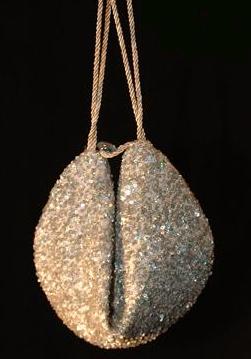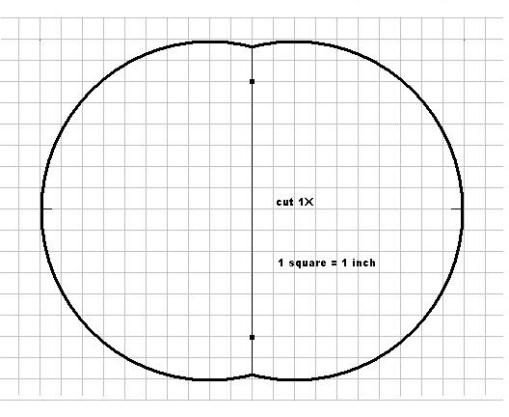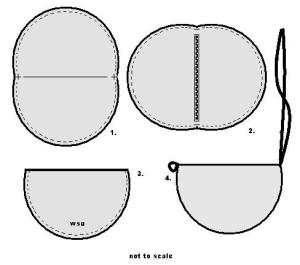
Step out with your Valentine with this heart-shaped disco bag.
You will need:
- fashion fabric, 45″ wide
- lining, 45″ wide
- polyester fleece interfacing
- Transfer web
- cable cord, ½” dia.
- coordinating thread
- 1 dome snap set or Velcro tab, ½” dia
- 1 tasseled decorative cord for bag strap
- kraft paper
PATTERN

Make a circle. Measure the diameter (D).
Make a square with sides equal to D + ½”.
Cut circle in half.
Fold square in half matching opposite corners. Open fold.
Join semi circles to square matching Xs and Os to form heart shape.
Draw a 1″ dart between the semi circles 4″ long.
Bag Tab for closure – make a rectangle 3″ wide and 1/2 the diameter of the circle. (1/2 D)
Add ½” seam allowances to all pattern pieces.
CUTTING
 Fuse fleece interfacing to back of fashion fabric using transfer web before cutting out bag front & back and bag tab. Follow manufacturer’s direction for application.
Fuse fleece interfacing to back of fashion fabric using transfer web before cutting out bag front & back and bag tab. Follow manufacturer’s direction for application.
Bag Shell – cut 2X self
Bag Lining – cut 2X lining
Tab – ½ D long x 3″ wide, self
Bias Strips for piping – 1″ wide (enough to go around perimeter of heart shape)
Cable Cording – perimeter of heart + 2″
ASSEMBLY
Make Piping
Make up corded bias piping. Join enough bias strips for the required length and wide enough to cover the cable cord plus the seam allowance. Lay the  cord in the centre, on the wrong side of the bias strip.
cord in the centre, on the wrong side of the bias strip.
Fold the bias strip over the cord matching the raw edges. Stitch the 2 sides of the bias strip together along the length. Use a zipper foot or cording foot on the sewing machine to ensure that the stitches are close to the cord.
Trim Bag Front
Place the corded piping around the outer edge of the interfaced heart piece, right sides together (RST) and matching the raw edges. Align the seams on the piping, allowing 1″ extra and begin at the dart; continue around the perimeter of the bag so that the piping gently curves around the heart shape (clip piping seam allowance if necessary). Finish at the dart and allow 1″ extra again. Carefully clip and remove the filler (cord only) from ends of the piping and crisscross the ends to neaten. Baste in place, 1/2″ in from the raw edges. Sew piping in place using a zipper foot.
Carefully cut through center of dart. Place ends of piping flat in center of dart. Fold heart in half and sew up dart to encase piping ends.
At bottom of dart (●), attach bottom portion of dome snap set, according to manufacturer’s instructions. Set aside.
Front Bag Lining
Make a square patch pocket and place it in the center of one lining piece beneath the dart. Topstitch in place, leaving the top edge open. Sew up the dart.
With wrong sides together (WST), align and match the heart shape of the lining to the piped fashion fabric and baste together around the top part of the heart shape between the “O”s.
Stitch around the top edge using ½” seam allowance. Grade and trim seam allowance if necessary. Clip seam allowances at point O. Turn front bag section right side out and press edge flat. Topstitch along edge if desired. Baste the open edge of lining to the wrong side of the front piece from the Os to the point of the heart shape.
Bag Back Section and Lining
Sew up the dart on the bag back portion and on back lining piece.
With WST, align and match the heart shape and baste together around the top part of the heart shape between the “O”s.
Stitch around the top edge using ½” seam allowance. Grade and trim seam allowance if necessary. Clip seam allowances at point O. Turn back section right side out and press edge flat. Topstitch along edge if desired.
Apply the top portion of the dome snap set to the bag tab, according to manufacturer’s directions.
Attach tab closure to face of back section, securing it at the bottom of the dart.
Joining Bag Front to Back
With WST, align and match the front and back sections following the heart point shape.
(Do not include the back lining.) Pin /baste together and sew along the piping using a zipper foot. Grade seam allowance and trim point.
Turn under seam allowance of back lining and align folded edge with the machine-stitching. Slipstitch the opening edge of the lining closed.
Turn bag right side out.
Finishing Bag
Hand-stitch ends of tasseled cord securely at points O.



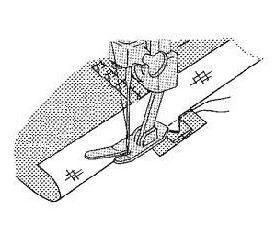




 Make stole pattern approx. 16″ X 80″. Round the ends with a circular template (I used a large pie plate). Position slit opening 4″ from one end.
Make stole pattern approx. 16″ X 80″. Round the ends with a circular template (I used a large pie plate). Position slit opening 4″ from one end.
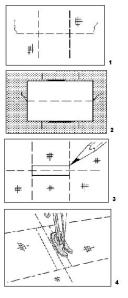














 Straighten the fabric edge you want to fringe.
Straighten the fabric edge you want to fringe.


